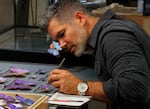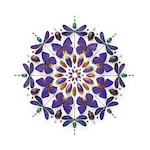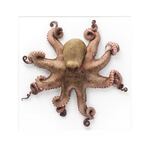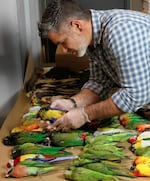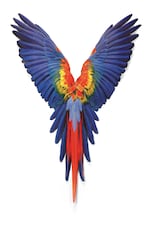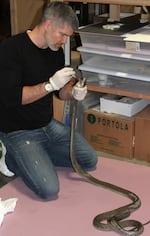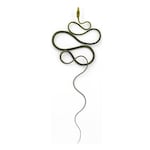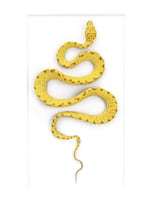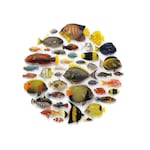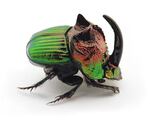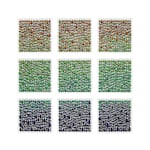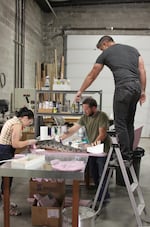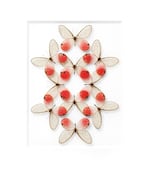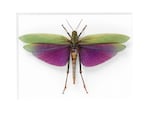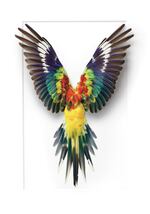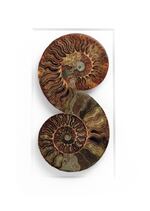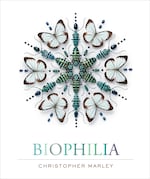
Christopher Marley
“I’m going to grab some venomous reptiles,” Christopher Marley says as he’s giving me a tour of his 10,000-square-foot studio warehouse outside Salem, Oregon.
“These are all pythons and venomous reptiles,” he says, opening the same type of cooler your grandma uses for ice cream overflow in the basement. “There are very few venomous reptile breeders and even institutions left in America.”
Green mamba, gaboon viper, canebreak rattle snake — he pulls them out one by one, frozen solid in plastic bags. Oh, and a forgotten stash of baby alligators.
Marley has one of those perfectly stubbled superhero jaws, biceps like boa constrictors, and styled salt-and-pepper hair. He used to be a model, but now he runs this warehouse and another in Malaysia and employees two-dozen people to transform insects, animals, and minerals into incredible works of art.
We’re not talking butterfly boxes or your favorite hipster bar taxidermy here. Marley’s creations range from arrays of beetles that shine so vibrantly they look forged of chrome, to snakes coiled in patterns that will remind you of intricate necklaces or gothic sculptural reliefs — so intentionally composed they could be logos. There’s also the colorful wings and tails of macaws, spread like you’re seeing them soaring from above. But my favorite are the octopi (octopuses or octopodes, if you will). Their tentacles splay in seemingly careless spirals, so voluptuous you can’t believe they’re not alive.
“You’re seeing the beauty of something and appreciating it in a different way than you would if it were alive and it were crawling around,” says Melanie Johannson, the Curator of the Cornell Art Museum, which included Marley’s insects in an exhibition earlier this year. “That in itself is very interesting, the way the thing changes into an art object once it’s displayed in these beautiful mosaic arrangements.”
And their beauty has attracted a lot of attention. Beyonce blogged about Marley’s mosaics in the early days of her BeyHive blog, and Nike CEO Mark Parker cited Marley’s beetles as inspiration for an iridescent shoe and invited Marley to collaborate on track spikes for the Olympics in Rio. His works sell at 1,000 stores around the world, from Bergdorf Goodman in New York, to Twist and Mitchell Gold & Bob Williams in Portland; and earlier this year he released his second book, “Biophilia,” with the art book publisher Abrams.
Produced by Nicolas Walcott, Garrett Guinn, Chloe Huckins, Jordan Bentz, and the UO School of Journalism and Communication for NW Stories, in partnership with OPB
Marley originally started collecting bugs as a therapy of sorts to deal with an insect phobia while he was hopscotching the globe as a model for brands like Nike, Sprite, and Donna Karen. After seeing a mansion in South Africa that seamlessly integrated nature, he decided in 1998 to transform his shabbily-framed specimens into something with an eye for beauty and design. As a test, he took the works to 10 different boutiques in Beverley Hills. Eight wanted to place orders right away, and he was off.
Marley started backtracking through the countries he'd visited. Instead of sourcing fabrics, he sourced lepidopterists, coleopterists, entomologists, and naturalists of all stripes. Then, he branched into shells. Then minerals. Then parrot feathers he gathered in his father's aviaries.
Because, it just so happens, his dad is a breeder of rare color mutations of Australian parrots.
"I started realizing throughout my whole life, we always had dead birds in our freezer — my dad couldn't bear to throw these beautiful birds away," he says. "I realized if my dad does this with birds, I'll bet you that most people who deal with any type of organism that they're in love with, that they probably do the same thing. So I started going back and contacting all of my contacts from museums and institutions and breeders and importers and seeing if I could work out an arrangement where I could buy their dead specimens."
Now he has a worldwide network of suppliers. He gets minerals from what he calls "the royal family of specimen miners in India." He gets megalodon teeth fossils from divers who comb a few select rivers in South Carolina. Insects come from indigenous collectors and tribes. And he gets his animals from a rolodex of breeders, zoos, museums, and other institutions.
"When something dies of natural or incidental causes, they throw it in a freezer, and then when the freezer's full, they ship it to me, and we try to make use of it, make beautiful out of it," says Marley.
His next step is to grade and sort the material, as much of it is too rotten to use.
"I've got to work around some fairly disgusting parameters sometimes," he says, as he continues to go through the freezer of venomous snakes. "When I can shape it the way that I want to, I like to be true to the form of the snake but give it a little more of a perfection than you might see. The weighting of the line needs to be bilaterally symmetric. I want to be able to imbue a certain type of dangerous beauty."
Then he starts the preservation process. Insects and mollusks, anything with an exoskeleton, are easy. They just needs to be dried and fumigated to protect them from beetles. But vertebrates are much harder. He uses a mix of methods, including chemical baths and freeze-drying.
"It's lots of trial and some error," he says. "I'm a horrible student and great hack. My technicians are more intelligent."
Unlike taxidermy, which just keeps the animal's skin, Marley preserves the entire organism. The technique he's pioneered works on animals like fish and octopi that he doesn't think have been preserved in dry settings. Most scientists keep them in jars of alcohol. And Marley says he's actually fielded calls from scientists about his process.
Indeed, the Academy of Natural Sciences of Drexel University — which has the oldest collection of insects in the new world — featured Marley's insect work in a show alongside specimens from its collection.
"I'm bowled over by his stuff — it's amazing," says Greg Cowper, the curatorial assistant at the academy's department of entomology. "He has really been an emissary to show how beautiful the natural world is."
Marley is currently working on a series of traveling museum exhibitions that will include the pieces and ideas in "Biophillia," alongside interactive installations to encourage people to explore nature on their own. Because, as Marley has discovered, when you put a piece of nature in a frame, you realize that we're surrounded by art in the natural world every day.

